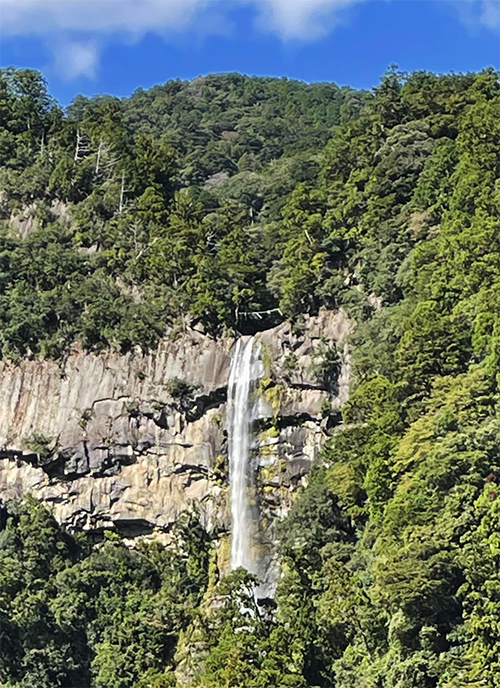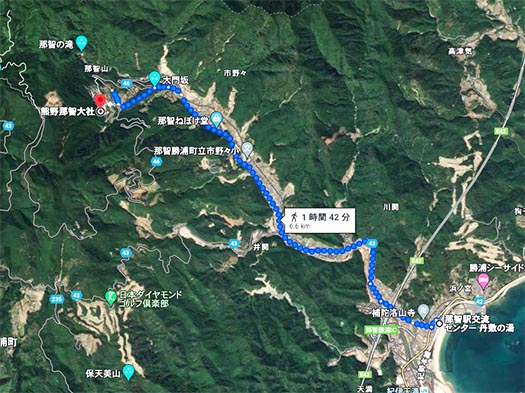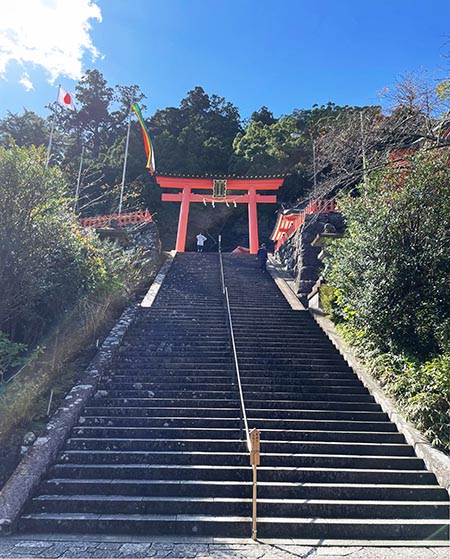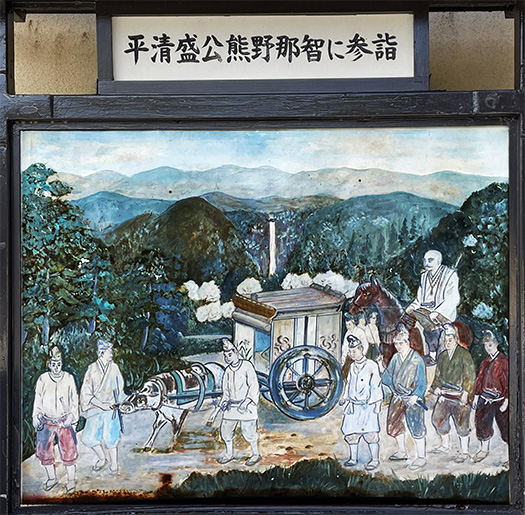

さて熊野三山のうちの熊野那智大社であります。現代とは違って、古代以来、人里のある熊野灘の海岸線道からながい山道をはるばると参詣するのは、けっこうな気合いが必要だったのではないか。
現代の整備された参詣道でも歩く場合は1時間42分という表示だけれど、上りの山道なので、かなりキツい行程だと思う。熊野詣を繰り返した中世の皇統、上皇の一行などはかなりの人数でもあり、相当の健脚だったことがわかる。
本当に古代以来の人びとの神聖なるものへの帰依の深さを思わされる。
深い山中で写真のような瀧を仰ぎ見た人びとの自然な感情に思いが至る。映画もテレビもない時代、こういったビジュアルが眼前に広がっている様子に驚き、自然が生み出す驚異に信仰心を持ち、そして深めて行っただろうことはたしかに理解できる。
主祭神は熊野夫須美大神(くまのふすみのおおかみ、イザナミノミコト)。きのうまで見ていた花の窟神社と同じ。国生みの母神がこうした自然崇拝と一体化しているのは同様。人類の抱く自然な感情として、水には女性的、母性的なるものが仮託されるものなのだろうか。夫須美(ふすみ)とは「むす」という生成発展を意味する言葉であり、同時に「結(むすび)」の意味という。
さらに祭神としては以下。
第一殿 瀧宮(大己貴神)大国主神。
第二殿 証誠殿(家都御子大神)ケツミコ〜スサノオ。
第三殿 中御前(御子速玉大神)熊野速玉神社の祭神。
第四殿 西御前(熊野夫須美大神)これがイザナミ尊。
第五殿 若宮(天照大神)アマテラス。
第六殿 八社殿(天神地祗)その他八百万ということか。

現代では鳥居のすぐ下に駐車場があって、そこにクルマを停めて急峻な階段を上って神前に出られる。国道からクルマでの「参道」行きという手軽な参詣が可能。古代の人びとの御利益とは大きくレベル低下しているだろうなと思わされる。
そういえば、境内で平清盛が上皇と同道して、熊野詣を繰り返した様子の絵伝を目撃した。

「平家の宰相・清盛公は熊野那智に対する信仰深く、とりわけ如意輪観世音の霊力を願い、1163年、後白河法皇を那智に迎え初度参詣の折、その行列の供として一族を引き連れてともに参詣し、如意輪の瀧と言われる二の瀧に於いて開運招福を願ったという。」という説明記述。
朝廷内で平家が権力を強化していくことの裏には、こういった皇統に対しての周到な接近・随伴的工作が行われたのだろうことがハッキリ見て取れる。熊野信仰というものがどのように利用されたのか、わかりやすい証拠とも言えるだろうか。
またこの絵伝からは、さすがに法皇は牛車に乗車し、清盛は馬に乗って参詣道を歩んでいることもわかる。神代と中世的権謀の世界とが、シンクロを見せ始めているのか(笑)。
English version⬇
Kumano Nachi-taisha Shrine, the Sacred Waterfall – A Journey to Kumano and the Myth of the Imperial Family – 24
The sacred body of Nachi-taisha Shrine is also a holy waterfall. It is a sacred waterfall, and the primordial form of Japanese faith is engraved in its roots. Even the shadow of Kiyomori is flickering in the distance. The waterfall is also a holy waterfall.
Now, let’s take a look at Kumano Nachi-taisha, one of the three Kumano-sanzan shrines. Unlike today, it must have taken a lot of energy to make the long pilgrimage from the coastline of the Kumano-nada Sea, where there is a human settlement, to the shrine on a long mountain road since ancient times.
Even on the modern well-maintained pilgrimage route, it takes 1 hour and 42 minutes to walk, but it is an uphill mountain path, so it must have been quite a strenuous journey. The number of people who repeatedly made the Kumano Pilgrimage, such as the members of the imperial lineage and emperors of the medieval period, must have been quite large, indicating that they were in good physical condition.
It is truly a reminder of the depth of devotion to sacred things that people have held since ancient times.
It makes me think of the natural feelings of the people who looked up at the waterfall like the one in the picture in the deep mountains. In an age without movies or television, we can understand how people would have been amazed at the sight of such visuals spread out before their eyes, and how they would have developed and deepened their faith in the wonders created by nature.
The main deity is Kumano Fusumi no Okami (Kumano Fusumi no Mikoto, Izanami no Mikoto). This is the same deity as at the Hana-no-Kutsu Shrine, which we had seen until yesterday. The same is true of the mother goddess of national birth, who is united with this kind of nature worship. I wonder if water is a natural emotional center for human beings, in which something feminine and motherly is entrusted. The word “fusumi” is said to mean “musu,” or generation and development, and at the same time, “musubi,” or union.
The deities of the shrine are as follows
First Hall: Takimiya (Okonoki-kami), the deity Okuninushi.
The second hall, Shoseiden (Ietomiko-no-okami): Ketsumiko – Susanoo.
Third Hall: Naka-gozen (Goko-Hayatama), the deity of Kumano Hayatama Shrine.
Fourth Hall: Nishigozen (Kumano-Osumi no Mikami) This is Izanami no Mikami.
Fifth: Wakamiya (Amaterasu), the deity Amaterasu.
The sixth hall, the eight main shrines (八社殿) (天神地祗), are the deities of the eight million other shrines.
In 1163, when the Heike clan welcomed Hōnō Go-Shirakawa to Nachi and made their first pilgrimage to the temple, he took his family along with him as an escort and prayed for good fortune at the two waterfalls known as Nyoirino-Taki. This is a description of the Heike family’s power within the Imperial Court.
It is clear that behind the strengthening of the power of the Heike clan within the Imperial Court, there must have been a careful approach to the imperial lineage and accompanying maneuverings such as this. This is a clear evidence of how the Kumano faith was utilized.
The pictorial record also shows that the emperor rode in an ox cart, while Kiyomori rode on horseback along the pilgrimage route. Are we beginning to see a synchronization between the world of the Jindai and the medieval world of power and intrigue (laugh)?
Posted on 1月 28th, 2024 by 三木 奎吾
Filed under: 日本社会・文化研究







コメントを投稿
「※誹謗中傷や、悪意のある書き込み、営利目的などのコメントを防ぐために、投稿された全てのコメントは一時的に保留されますのでご了承ください。」
You must be logged in to post a comment.